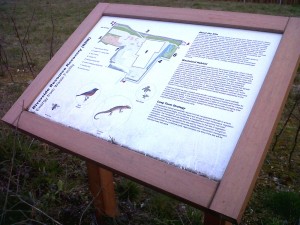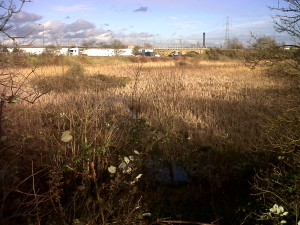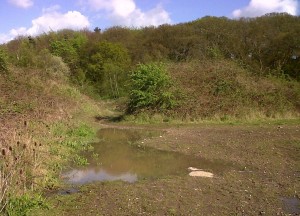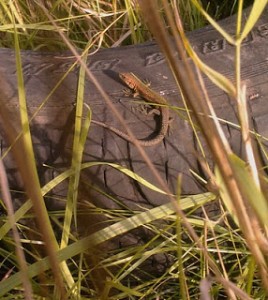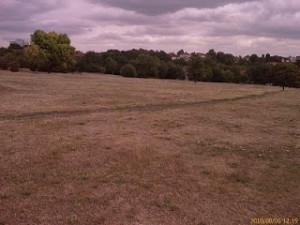A small colony of Rue-leaved Saxifrage (Saxifraga tridactylites), a small spring-flowering annual, was found by me in Crayford town centre on March 12th, growing between clumps of moss on a pad of concrete, and in bare ground in short grass, inside the curve of the utility company fenceline at the junction of Station Road and Crayford Road. There are only a handful of previous records from in and around the Borough of Bexley. I am told that the Lesnes Abbey population survives or was at least still extant in 2011. One on the North Cray Road was extirpated. I had a failed attempt to re-find it at Hall Place on March 14th, and St. Mary’s churchyard Old Bexley and Bexley station need to be re-checked. I have also had a look in Christchurch cemetery, Bexleyheath, just in case – but to no avail.
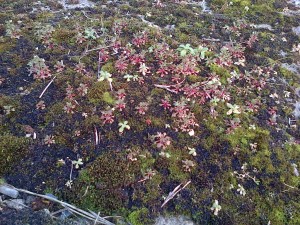
This Rue-leaved Saxifrage colony in Crayford town centre on 12/3/16 is a new site record for a scarce London plant. (Photo: Chris Rose)
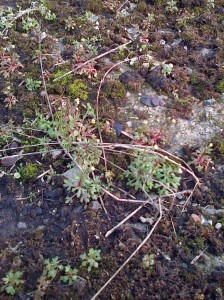
This closer view of Rue-leaved Saxifrage shows the tripartite lower leaves, hence the scientific name tridactylites. (Photo: Chris Rose)
Rodney Burton, author of the last London Flora, produced in 1983, which said the plant had undergone a serious decline in the capital, is now of the view that it has since had a bit of a revival, mostly on railway tracks. He says that he has looked for it in St. Mary’s churchyard and Hall Place many times over a long period without re-finding it there. Since 2011 there have been records from single sites in Greenwich and Bromley. Further out, he has seen it recently in streets in Swanley and Greenhithe. It does seem to be associated with the built equivalent of rocky habitat, and Rodney says “It seems to me that the seeds get carried so far by the wind, and then hit a wall and drop”.
On March 14th I found an Erigeron, which appears to be E. glaucus, a native of California and Oregon, by the A2 crash barrier between Penn Lane and Bexleyheath Golf Course. I have seen this plant in a number of Bexley gardens, but this is the first occasion I have seen it ‘in the wild’ in our Borough or anywhere else, though the Botanical Society of the British Isles distribution map shows it is a fairly frequent escapee, particularly in the London area.
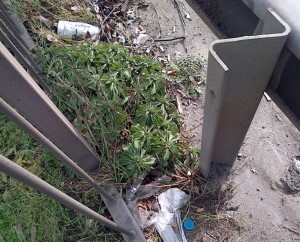
Erigeron (probably glaucus) by the A2 near Bexleyheath Golf Course on 14/3/2016. (Photo: Chris Rose)
On March 17th I recorded Barren Strawberry in flower in Danson Park, the first time I’ve seen it here. It’s supposed to be common in and near woodland, and is most frequent on the northern and southern flanks of the capital. But in Bexley the only other places I have found it to date are in a couple of cemeteries and at Martens Grove, where a nice patch was in flower later in the day and, from memory, Lesnes Abbey Woods. More determined searching will probably reveal more locations for it in the Borough.
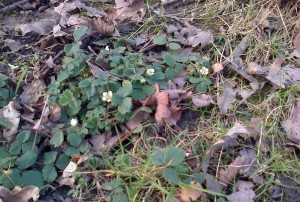
Barren Strawberry (Potentilla sterilis) in flower at Martens Grove on 17/3/2016. (Photo: Chris Rose)
Also on the 17th I came across what may well be an entirely new record for Bexley in the shape of Musk Stork`s-bill (Erodium moschatum), a species I was aware of but had never seen anywhere before, with several specimens growing – and already in flower – in grass at the junction of Park View Road and Denham Close, Welling. This is a far larger and more robust relative of the small Erodium cicutarium, which is found chiefly in closely mown or trampled turf in sandy parts of the Borough. E. moschatum is in some quarters classed as an achaeophyte, which is a non-native plant first introduced prior to 1492, when Christopher Columbus arrived in the New World. It has a Mediterranean-Atlantic distribution, but is widely naturalised outside this range. In Britain it is well-established in the coastal regions of S.W. England, Wales and Ireland, where it is often considered a native. Elsewhere it is encountered as an uncommon casual.
The London biodiversity records centre (GiGL) has no records of it for Bexley and Rodney Burton agrees it is probably new, saying of Musk Stork`s-bill “I saw it in Lewisham on Sunday (13th) and there are a couple of recent records from Bromley and a few further out in Kent as well”. There is also a record from Stonehill Green by Dartford Heath.
Chris Rose

